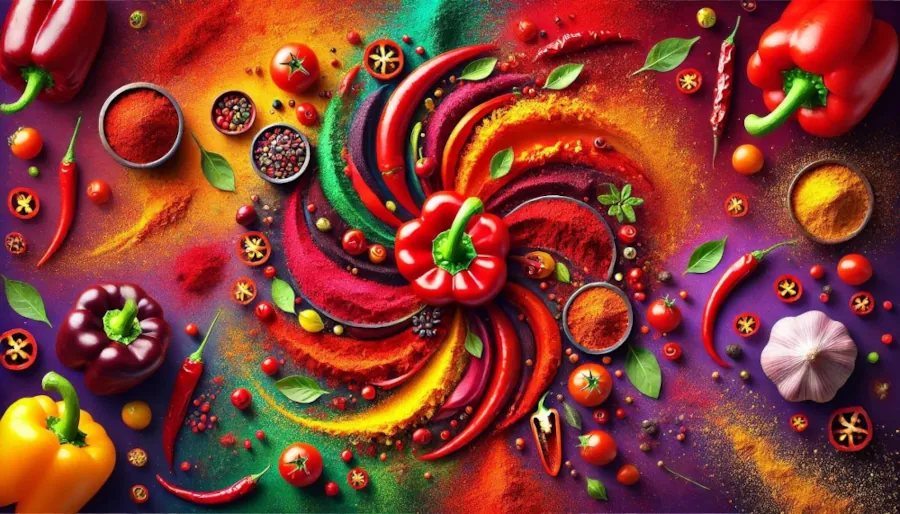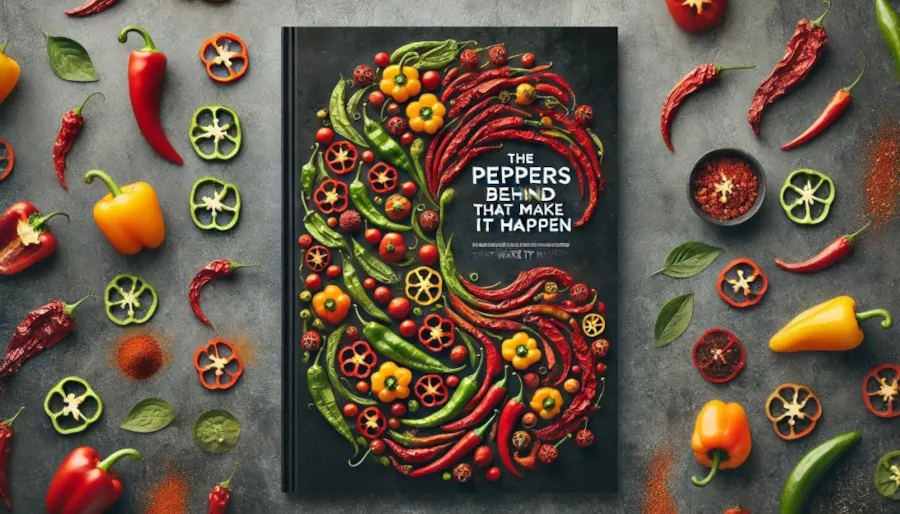What is Paprika Made Of?

Think of opening a jar of paprika and letting the warm, faintly sweet, and smoky notes drift to your nose. The red alone would tempt spectators to your dish. But have you ever wondered what paprika is made of?
Most of us simply grab the bottle from the spice rack, sprinkle it over the prepared food, and forget it.
But this greenish spice has really an interesting story to tell, from the fields of the growing peppers to how they are dried, grounded, and converted into the fine powder that enchants your kitchen.
Things could get really interesting if we started discussing the topics involved in the making of paprika, where the stuff is locally produced, and instances of how it comes to be used as a kitchen ingredient around the world.
What is a Parika? The Basics
People prepare paprika as a ground spice by drying red peppers from Capsicum annuum varieties. A wide variety of peppers are used to make paprika.
Each variety used for making paprika affects its coloring and taste along with temperature intensity during processing.
The consumption of paprika extends across Hungarian, Spanish, and Mediterranean cuisine styles, and its hotness scale and spicy-sweet notes depend on its production methods.
The Peppers Behind The Scenes That Make It All Happen

The manufacturing process of paprika starts with red bell peppers along with chili peppers or their combination. Paprika flavor depends entirely on the selection of peppers during manufacturing.
There are three main types of pepper varieties used to create paprika. They are:
- Sweet Chiles: The same types of peppers, such as red bell peppers, can be seen in a grocery store. They make a sweet, light-theory paprika.
- Hot Chili Peppers: Some types of paprikas include hotter peppers that give a kick.
- Smoked Pepper: The great part about this type is that it is made using a red pepper that is well smoked, which is quite popular in Spain, and it has a very distinct taste like a BBQ.
The secret is in knowing exactly how to blend those types in a way that makes excellent paprika, which also accounts for the different geographical types that exist across various areas.
How is a Paprika Prepared?
To create paprika, you need more than basic pepper grinding skills because the production process demands precise attention and patient handling throughout its execution. So we are going to show you how.
- Growing the Peppers:
Paprika indeed starts its journey from a farm where the pepper is grown under the sun in warm climates.
There is no doubt that Hungary and Spain produce the best quality paprikas. However, the United States and India are also producing paprika peppers.
The harvesting of the peppers meant for paprika takes place in the course of late summer or early autumn when the peppers have matured into their desired deep red color.
- Drying Up the Peppers:
The peppers have to be dried up after harvest so that moisture will not remain. There are different ways to dry the peppers:
- Sun-Drying: Traditional ways of doing this are by just leaving the peppers out in the sunlight to dry.
- Air Drying: In certain regions, people string their peppers across lines and leave them dry in the air.
- Smoking: In Spain, particularly regions like La Vera, they usually dry these peppers over a wood fire.
With this, they would already taste quite smoky. This is exactly how Spanish smoked paprika (Pimentón de la Vera) would get its distinctive flavor.
- Finally, Grinding them Up:
The peppers become ground into a delicate powdered consistency after the completion of the drying process.
Cauliflower has two different processing approaches during grinding, with some versions keeping seeds and internal membranes along with their powdery substance but alternative versions removing all material.
The quality of ground paprika heavily depends on the conditions during grinding. Among different types of ground paprika, some producers run their products multiple times to achieve maximum fineness.
Different Types of Paprika: How They Come Into Existence?
Not all paprika are the same. Each type of Paprika is unique, as it is made from peppers and processed in a number of different ways from all over the world.
Here is a list of those peculiar ones:
- Sweet Paprika
Made from Mildly Sweet Red Pepper.
Has a bit of a sweet, fruity, and slightly earthen taste.
It is very commonly used as a garnish ingredient for deviled eggs or sprinkled lightly on roasted vegetables.
- Hot and Spicy Paprika
Made from spicier chili peppers.
The heat level of this pepper differs according to its variety and ranges from mild to intense.
Common in Hungarian dishes like chicken paprikash.
- Smoked Paprika
Made from smoked red peppers.
The strong woodsy taste of this ingredient features slight sweetness along with its deep flavors.
Spanish cooking relies on this seasoning, which is found in paella preparation and chorizo preparation.
- Hungarian Paprika
Here, this variety of cayenne pepper can go from mellow sweet to extremely spicy.
Many individuals commonly use it as a primary ingredient during the preparation of Hungarian goulash and stew, together with other types of soups.
- Spanish Paprika
This dried product comes with three distinctive heat intensities (sweet, bittersweet, and hot) and stays fresh for a long period of time when smoked.
Essential in Spanish cooking, especially for meats and seafood.
What Gives Its Beautiful Color and Mouth-Watering Flavor
Natural red peppers in paprika obtain their bright color through carotenoids, which are natural pigments in the peppers.
Paprika acquires its unique taste from two ingredients: capsaicin for spiciness and natural sugars for sweetness.
Also, the process of smoking peppers allows them to absorb natural wood compounds that produce a novel taste apart from their original flavors.
How To Use Paprika in Your Home-Made Cookings?
- Just sprinkle some on top of eggs, potatoes, or roasted vegetables, and you will really turn up the volume.
- It matches really well with meats and dishes containing garlic, onion, cumin, and black pepper to add some scrumptious flavor.
- Hungarian paprika is the one you want to use with your seriously hot, mouth-watering stew.
- You can enrich many different Spanish dishes, such as paella, chorizo, or even grilled shellfish.
- Finally, you can throw it in marinades and dressings for something extra in-depth.
One note, of course, is that paprika has a tendency to burn really easily. When simmering paprika in oil, do take care to have the heat just low enough so that bitterness is kept at bay.
Conclusion: The Magical Tricks of Paprika
So, what is paprika made of? The basic ingredients for paprika involve dried green peppers that become ground into powder, yet its final taste, together with appearance, depends on the pepper variety, drying approach, and geographic source used.
Paprika exists as a story in each pinched amount because pepper growers dry their product in wood fire smoke chambers over sunlit fields.
The spice paprika truly stands out among other seasonings since you can use it to create traditional Hungarian dishes and Spanish treats as well as color any meal you prefer.
So, the next time you reach for that jar, enjoy a moment of remembering its history, its craftsmanship, and all those flavors stirred into your cooking.
FAQs
Is a paprika sweet or spicy?
A: It can be both sweet ones have a mild pleasant taste while the hot ones have a real kick to them.
What is the reason that makes it so different when smoked?
A: It is because it has a deep wood taste that the regular types don’t have.
Would chili powder serve as an acceptable substitute for the paprika measurement in this recipe?
A: One is a lot spicier, while the other has natural pure ground pepper, so they are both different.
